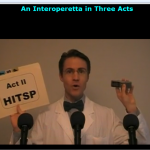HISPC releases Action and Implementation Manual
Joseph Goedert of HealthData Management reported on June 5, 2009 that “The Health Information Security and Privacy Collaboration (HISPC) has released a how-to guide for state cooperation in health care privacy and security issues.” Referred to as AIM (Action and Implementation Manual), it’s the result of collaborative work between 42 states and territories. According to HISPC site, the ”AIM serves as a how-to guide for each of the seven multistate collaboratives’ tools and templates.”
AIM was prepared for Jodi Daniel, JD, MPH, Director and Steven Posnack, MHS, MS, Policy Analyst of the Office of Policy and Research of the Office of the National Coordinator for Health IT. AIM was prepared by Linda L. Dimitropoulos, PhD of RTI International, Chicago and released in June 2009.
HISPC Site: http://healthit.hhs.gov/HISPC
Action and Implementation Manual 45-page pdf:
http://healthit.hhs.gov/html/hispc/AIMReport.pdf
HISPC Phase 3 Executive Summary (Background on AIM) pdf: http://tinyurl.com/lyrdpb
HISPC June 2009 Seminar Series
“The Seminar Series will be held throughout the month of June on Tuesdays and Thursdays and will include eight 90-minute online seminars. Each seminar will highlight the work and results of the seven HISPC multi-state collaboratives as well as follow-up analysis on state law variation completed by Georgetown University. The HISPC Collaborative presentations will focus on the tools and processes developed and how they can be used by individual, local, regional, and state-level stakeholders.”
http://privacysecurity.rti.org/Default.aspx?tabid=101
HISPC Provider Education Toolkit Video
The HISPC Toolkit for physicians and other healthcare providers ”video {page down on the Press Kit and Tools Web page} was presented at the National HISPC Conference in Bethesda MD in March 2009 and provides a powerful message about electronic health information technology and exchange and the related privacy and security aspects. Please feel free to use this video at any event where health care providers would benefit from awareness of these issues and how to tap in to the Provider Education Toolkit websites and resources.”
http://www.secure4health.org/media.aspx
Health Information Security & Privacy Provider Education Toolkit
http://www.secure4health.org This Web site (including the video featured above) and its resources, built as one of the seven collaborative projects of HISPC, is a treasure and roadmap for educating providers and consumers. “Welcome to the Health Information Security & Privacy Provider Education Toolkit designed especially for physicians and the healthcare community. We invite you to explore our Web site, learn more about electronic health information exchange, related privacy and security implications, earn free CME credits, ask questions, and get the tools and resources you need to safely and securely get connected! ”
http://www.secure4health.org
Thanks to Fred Pennic of Healthcare IT Consultant Blog
Today’s email update from Healthcare IT Consultant Blog, produced by Fred Pennic, and his brief on the HISPC release of AIM, brought the program to my attention and led me down the path of discovery of these resources. Thank you Fred Pennic.
http://hitconsultant.blogspot.com
HISPC National Conference: March 4-6, 2009 Bethesda, MD
Presentations from ”conference showcased the common, replicable solutions developed by seven multi-state collaboratives to the privacy and security challenges presented by the implementation of electronic health information exchange at the state and organizational level.”
HISPC site with relevant working documents: http://privacysecurity.rti.org/

